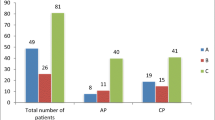Abstract
Cervical myelography, by injecting contrast medium on the C1/C2-level, combined with a supplementary myelo-CT, still has a place, compared with MR-myelography, in the diagnosis of cervical disc diseases. But many patients are afraid of the efficient and excellent diagnostic possibilities by using cervical myelography. Therefore the intention of the study was to analyze anxiety of patients prior to cervical myelography by using objective methods and to find ways of detecting anxious patients during clinical routine.
Twenty-eight patients (12 female and 16 male) volunteered in the study. After being informed about the cervical myelography one day before the examination by their physician in the ward, the patients filled a standardized questionnaire booklet (STAI XI, complaint list, analogue scales pain and quality of life) just before the myelography. Additional clinical and social data were asked.
It became obvious that female patients are more anxious and experience less quality of life than males. Social aspects and duration of complaints have no influence on anxiety. But patients who admitted their anxiety before cervical myelography experience significant more anxiety and complaints and less quality of life. No correlation with duration of fluoroscopy was found.
Female patients and patients who admit their anxiety prior to myelography need more and individual information about this examination.
Zusammenfassung
Die zervikale Myelographie durch Injektion von Kontrastmittel in Höhe C1/C2 (mit anschließendem Myelo-CT) ist neben der MR-Myelography immer noch eine alternative Diagnosemethode, auch in unklaren Fällen, bei der Abklärung von zervikalen Diskopathien. Jedoch haben Patienten oft Angst vor dieser Untersuchungsmethode. Daher sollte in dieser Studie versucht werden, die Ängstlichkeit der Patienten vor einer Myelographie zu objektivieren und Möglichkeiten zur Erkennung von hochängstlichen Patienten zu finden.
Insgesamt 28 Patienten (zwölf Frauen, 16 Männer) wurden mittels standardisierter Fragebögen (STAI X1, B-L. Analogskala Lebensqualität/Schmerz) nach am Vortag erfolgter Aufklärung durch den behandelnden Stationsarzt unmittelbar vor der Myelographie evaluiert. Außerdem wurden die soziale Situation, Beschwerdendauer, Vorerfahrungen mit Myelographien und eventuell bestehende Befürchtungen hinsichtlich der Untersuchung erfragt.
Es zeigte sich, daß Frauen ängstlicher als Männer sind und eine schlechtere globale Lebensqualität angeben. Die soziale Situation und die Beschwerdendauer hatten keinen Einfluß auf die Ängstlichkeit. Jedoch zeigten Patienten, die auf direkte, Befragung hin ihre Angst zugaben, signifikant höhere Ängstlichkeit, mehr Beschwerden und erlebten eine schlechtere globale Lebensqualität. Zusammenhänge mit der Durchleuchtungszeit wurden nicht gefunden.
Schlußfolgernd läßt sich sagen, daß vor zervikalen Myelographien Frauen und Patienten, die ihre Angst vor der bevorstehenden Myelographie zugeben, eine intensivere Aufklärung benötigen.
Similar content being viewed by others
References
AMDP and CIPS, eds. Ratingscales for psychiatry — European edition. Weinheim: Beitz Test GmbH, 1990.
Bundesministerium für Gesundheit: Großgeräte in Krankenhäusern und Praxen. Statistisches Taschenbuch Gesundheit. Bonn: 1996.
Cason CL, Sample JG. Preparatory information for myelogram. J Neurosci Nurs 1995;27:182–7.
Davis L, Soper B, Rosenthal GT. Structuring and anxiety reduction prior to myelography. Psychol Rep 1990;66:1171–6.
Davis TM, Maguire TO, haraphongse M, et al. Preparing adult patients for cardiac catheterization: informational treatment and coping style interactions. Heart Lung 1994;23:130–9.
Goyen M, Klewer J, Rothschild PA, et al. Communication eases patients anxiety over MRI. One-to-one consultations with patients prior to MRI may reduce the number of abortive examinations. Diagn Imag Eur 1997;13:15–18, 32.
Hergan K, Amann T, Vonbank H, et al. MR-myelography: a comparison with conventional myelography. Eur J Radiol 1996; 21:196–200.
Hunt SM, McKenna SP, McEwen J, et al. The Nottingham Health Profile: subjective health status and medical consultations. Soc Sci Med 1986;1 SA: 221–9.
Klewer J, Goyen M, Froese G, et al. Anxiety just before lumbar myelography and ways of detecting anxious patients during clinical routine (original article in German). Röntgenpraxis 1998;51:16–22.
Kugler J, Tenderich G, Stahlhut P, et al. Anxiety and depression before and after heart transplantation. Transplantoorum 1995; 1:37–9.
Kugler J, Tenderich G, Stahlhut P, et al. Relationship beteeen social support and anxiety after heart transplantation. In: Körner MM, Körfer R, eds. Current aspects and concepts of nursing, coordinating, bridging and rehabilitation in organ transplantation. Amsterdam: Elsevier, 1995;251–5.
Laux L, Glanzmann P, Schaffner P, et al. State trait anxiety inventory (STAI). Weinheim. Beltz Testgesellschaft, 1981.
Lee T, Maynard N, Anslow P, et al. Post-myelogramm headache — physiological or psychological? Neuroradiology 1991; 33:155–8.
Osborne AG, ed. Diagnostic neuroradiology, Chapt. 20: Nonneoplastic disorders of the spine and spinal cord. St. Louis: Mosby, 1994.
Perneczky G, Bock F, Neuhold A, et al. Diagnosis of cervial disc disease. MRI versus cervical myelography. Acta Neurochir 1992;116:44–8.
Poroch D. The effect of preparatory patient education on the anxiety and satisfaction of cancer patients receiving radiation therapy. Cancer Nurs 1995;18:206–14.
Porzolt F. Rationalisation and rationing in health care (original article in German). Münch Med Wochenschr 1996;138: 608–11.
Robertson H, Smith R. Cervical myelography: survey of modes of practise and major complications. Radiology 1990;174:79–83.
Rolfe EB, Maguire PD. The incidence of headache following various techniques of metrizamide myelography. Br J Radiol 1980; 53:840–4.
Smyth JS. Some problems of dental treatment. Part 1. Patient anxiety: some correlates and sex differences. Aust Dent J 1993; 38:354–9.
Spitzer WO, Dobson A, Hall J, et al. Measuring the quality of life of cancer patients. A concise of QL-index for use by physicans. J Chron Dis 1981;34:585–97.
Testa MA, Simonson DC. Assessment of quality-of-life outcomes. N Engl J Med 1996;334:835–40.
Vollmann J, Helmchen H. Informed consent in clinical routine (original article in German). Dtsch med Wochenschr 1997;122: 870–3.
von Zerssen D. Complaint list. Weinheim: Beltz Testgesellschaft, 1976.
Author information
Authors and Affiliations
Rights and permissions
About this article
Cite this article
Klewer, J., Goyen, M., Froese, G. et al. Anxiety Prior to Cervical Myelography. Klin Neuroradiol 8, 108–114 (1998). https://doi.org/10.1007/BF03043440
Received:
Accepted:
Issue Date:
DOI: https://doi.org/10.1007/BF03043440




